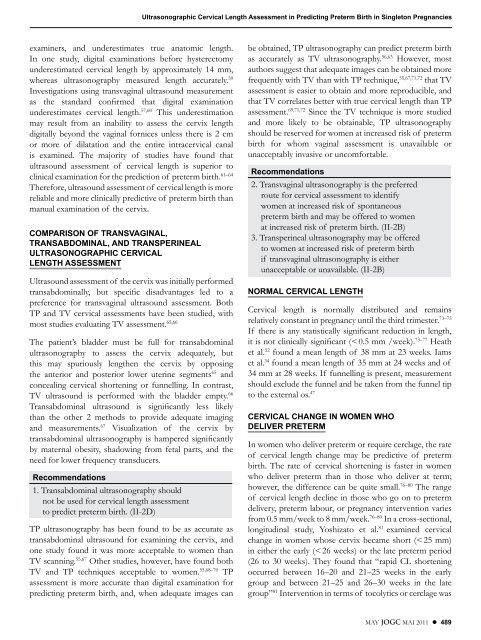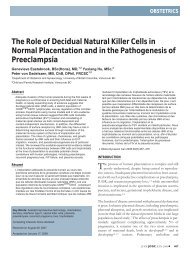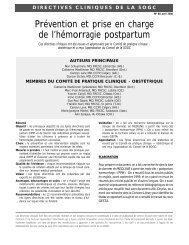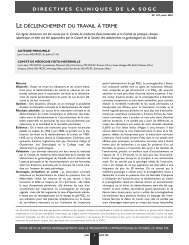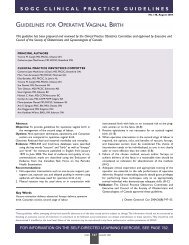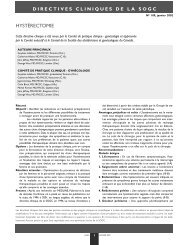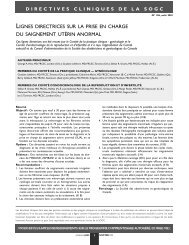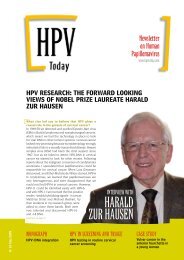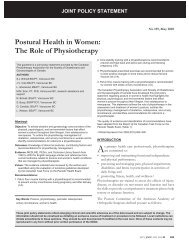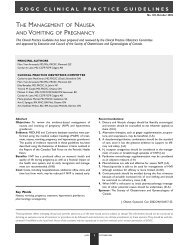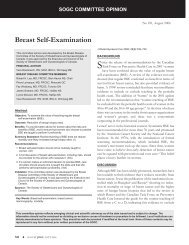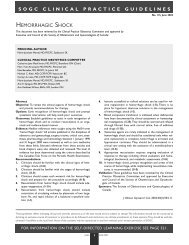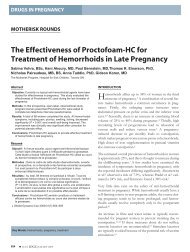Ultrasonographic Cervical Length Assessment in Predicting ... - SOGC
Ultrasonographic Cervical Length Assessment in Predicting ... - SOGC
Ultrasonographic Cervical Length Assessment in Predicting ... - SOGC
Create successful ePaper yourself
Turn your PDF publications into a flip-book with our unique Google optimized e-Paper software.
exam<strong>in</strong>ers, and underestimates true anatomic length.<br />
In one study, digital exam<strong>in</strong>ations before hysterectomy<br />
underestimated cervical length by approximately 14 mm,<br />
whereas ultrasonography measured length accurately. 59<br />
Investigations us<strong>in</strong>g transvag<strong>in</strong>al ultrasound measurement<br />
as the standard confirmed that digital exam<strong>in</strong>ation<br />
underestimates cervical length. 57,60 This underestimation<br />
may result from an <strong>in</strong>ability to assess the cervix length<br />
digitally beyond the vag<strong>in</strong>al fornices unless there is 2 cm<br />
or more of dilatation and the entire <strong>in</strong>tracervical canal<br />
is exam<strong>in</strong>ed. The majority of studies have found that<br />
ultrasound assessment of cervical length is superior to<br />
cl<strong>in</strong>ical exam<strong>in</strong>ation for the prediction of preterm birth. 61–64<br />
Therefore, ultrasound assessment of cervical length is more<br />
reliable and more cl<strong>in</strong>ically predictive of preterm birth than<br />
manual exam<strong>in</strong>ation of the cervix.<br />
COMPARISON OF TRANSVAGINAL,<br />
TRANSABDOMINAL, AND TRANSPERINEAL<br />
ULTRASONOGRAPHIC CERVICAL<br />
LENGTH ASSESSMENT<br />
Ultrasound assessment of the cervix was <strong>in</strong>itially performed<br />
transabdom<strong>in</strong>ally, but specific disadvantages led to a<br />
preference for transvag<strong>in</strong>al ultrasound assessment. Both<br />
TP and TV cervical assessments have been studied, with<br />
most studies evaluat<strong>in</strong>g TV assessment. 65,66<br />
The patient’s bladder must be full for transabdom<strong>in</strong>al<br />
ultrasonography to assess the cervix adequately, but<br />
this may spuriously lengthen the cervix by oppos<strong>in</strong>g<br />
the anterior and posterior lower uter<strong>in</strong>e segments 65 and<br />
conceal<strong>in</strong>g cervical shorten<strong>in</strong>g or funnell<strong>in</strong>g. In contrast,<br />
TV ultrasound is performed with the bladder empty. 66<br />
Transabdom<strong>in</strong>al ultrasound is significantly less likely<br />
than the other 2 methods to provide adequate imag<strong>in</strong>g<br />
and measurements. 67 Visualization of the cervix by<br />
transabdom<strong>in</strong>al ultrasonography is hampered significantly<br />
by maternal obesity, shadow<strong>in</strong>g from fetal parts, and the<br />
need for lower frequency transducers.<br />
Recommendations<br />
1. Transabdom<strong>in</strong>al ultrasonography should<br />
not be used for cervical length assessment<br />
to predict preterm birth. (II-2D)<br />
TP ultrasonography has been found to be as accurate as<br />
transabdom<strong>in</strong>al ultrasound for exam<strong>in</strong><strong>in</strong>g the cervix, and<br />
one study found it was more acceptable to women than<br />
TV scann<strong>in</strong>g. 55,67 Other studies, however, have found both<br />
TV and TP techniques acceptable to women. 55,68–70 TP<br />
assessment is more accurate than digital exam<strong>in</strong>ation for<br />
predict<strong>in</strong>g preterm birth, and, when adequate images can<br />
<strong>Ultrasonographic</strong> <strong>Cervical</strong> <strong>Length</strong> <strong>Assessment</strong> <strong>in</strong> Predict<strong>in</strong>g Preterm Birth <strong>in</strong> S<strong>in</strong>gleton Pregnancies<br />
be obta<strong>in</strong>ed, TP ultrasonography can predict preterm birth<br />
as accurately as TV ultrasonography. 56,63 However, most<br />
authors suggest that adequate images can be obta<strong>in</strong>ed more<br />
frequently with TV than with TP technique, 55,67,71,72 that TV<br />
assessment is easier to obta<strong>in</strong> and more reproducible, and<br />
that TV correlates better with true cervical length than TP<br />
assessment. 69,71,72 S<strong>in</strong>ce the TV technique is more studied<br />
and more likely to be obta<strong>in</strong>able, TP ultrasonography<br />
should be reserved for women at <strong>in</strong>creased risk of preterm<br />
birth for whom vag<strong>in</strong>al assessment is unavailable or<br />
unacceptably <strong>in</strong>vasive or uncomfortable.<br />
Recommendations<br />
2. Transvag<strong>in</strong>al ultrasonography is the preferred<br />
route for cervical assessment to identify<br />
women at <strong>in</strong>creased risk of spontaneous<br />
preterm birth and may be offered to women<br />
at <strong>in</strong>creased risk of preterm birth. (II-2B)<br />
3. Transper<strong>in</strong>eal ultrasonography may be offered<br />
to women at <strong>in</strong>creased risk of preterm birth<br />
if transvag<strong>in</strong>al ultrasonography is either<br />
unacceptable or unavailable. (II-2B)<br />
NORMAL CERVICAL LENGTH<br />
<strong>Cervical</strong> length is normally distributed and rema<strong>in</strong>s<br />
relatively constant <strong>in</strong> pregnancy until the third trimester. 73–75<br />
If there is any statistically significant reduction <strong>in</strong> length,<br />
it is not cl<strong>in</strong>ically significant (< 0.5 mm /week). 73–77 Heath<br />
et al. 52 found a mean length of 38 mm at 23 weeks. Iams<br />
et al. 34 found a mean length of 35 mm at 24 weeks and of<br />
34 mm at 28 weeks. If funnell<strong>in</strong>g is present, measurement<br />
should exclude the funnel and be taken from the funnel tip<br />
to the external os. 47<br />
CERVICAL CHANGE IN WOMEN WHO<br />
DELIVER PRETERM<br />
In women who deliver preterm or require cerclage, the rate<br />
of cervical length change may be predictive of preterm<br />
birth. The rate of cervical shorten<strong>in</strong>g is faster <strong>in</strong> women<br />
who deliver preterm than <strong>in</strong> those who deliver at term;<br />
however, the difference can be quite small. 76–80 The range<br />
of cervical length decl<strong>in</strong>e <strong>in</strong> those who go on to preterm<br />
delivery, preterm labour, or pregnancy <strong>in</strong>tervention varies<br />
from 0.5 mm/week to 8 mm/week. 76–80 In a cross-sectional,<br />
longitud<strong>in</strong>al study, Yoshizato et al. 81 exam<strong>in</strong>ed cervical<br />
change <strong>in</strong> women whose cervix became short (< 25 mm)<br />
<strong>in</strong> either the early (< 26 weeks) or the late preterm period<br />
(26 to 30 weeks). They found that “rapid CL shorten<strong>in</strong>g<br />
occurred between 16–20 and 21–25 weeks <strong>in</strong> the early<br />
group and between 21–25 and 26–30 weeks <strong>in</strong> the late<br />
group” 81 Intervention <strong>in</strong> terms of tocolytics or cerclage was<br />
MAY JOGC MAI 2011 l 489


